
H&M Case Study

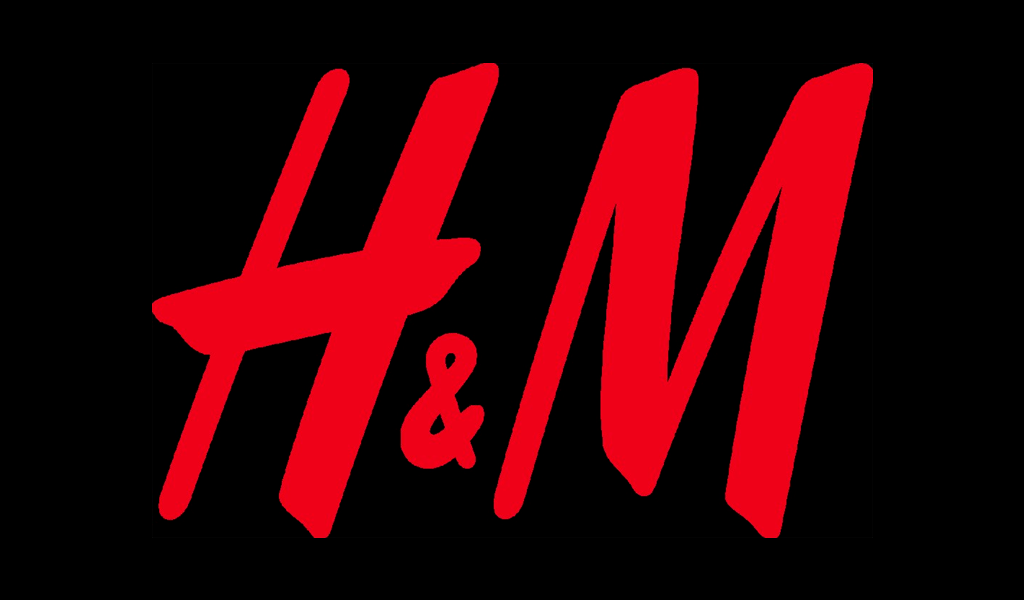
Introduction:
H&M, also known as Hennes and Mauritz, is a popular clothing store in India, even more popular than ZARA. They’ve become well-known for their clever marketing campaigns. One big thing they focus on is being socially responsible. They care about things like the environment, diversity, and making sure everyone feels included. H&M is famous for promoting sustainability and working with famous designers to spread their message. They want people to know that they’re committed to being eco-friendly. By being both sustainable and trendy, H&M has become a favorite for lots of people. This case study takes a closer look at H&M’s marketing strategies and why they’re so successful.
What is H&M?
Hennes and Mauritz, commonly known as H&M, is a Swedish clothing company catering to men, women, and children. Established in 1947 by Erling Persson, the company has expanded its presence to over 75 countries. Under the leadership of CEO Helena Helmersson, H&M boasts more than 4800 stores worldwide. Renowned for its versatility, H&M offers clothing options for individuals of all ages, sizes, body types, and ethnicities, making it a preferred choice across various demographics.
Notably, H&M has garnered praise for its societal and environmental responsibility initiatives. The brand actively engages in inclusive initiatives, diversity campaigns, and endeavors to reduce its carbon footprint while promoting sustainable manufacturing practices. These efforts resonate with a broad audience, earning H&M recognition for its commitment to quality and ethical practices.
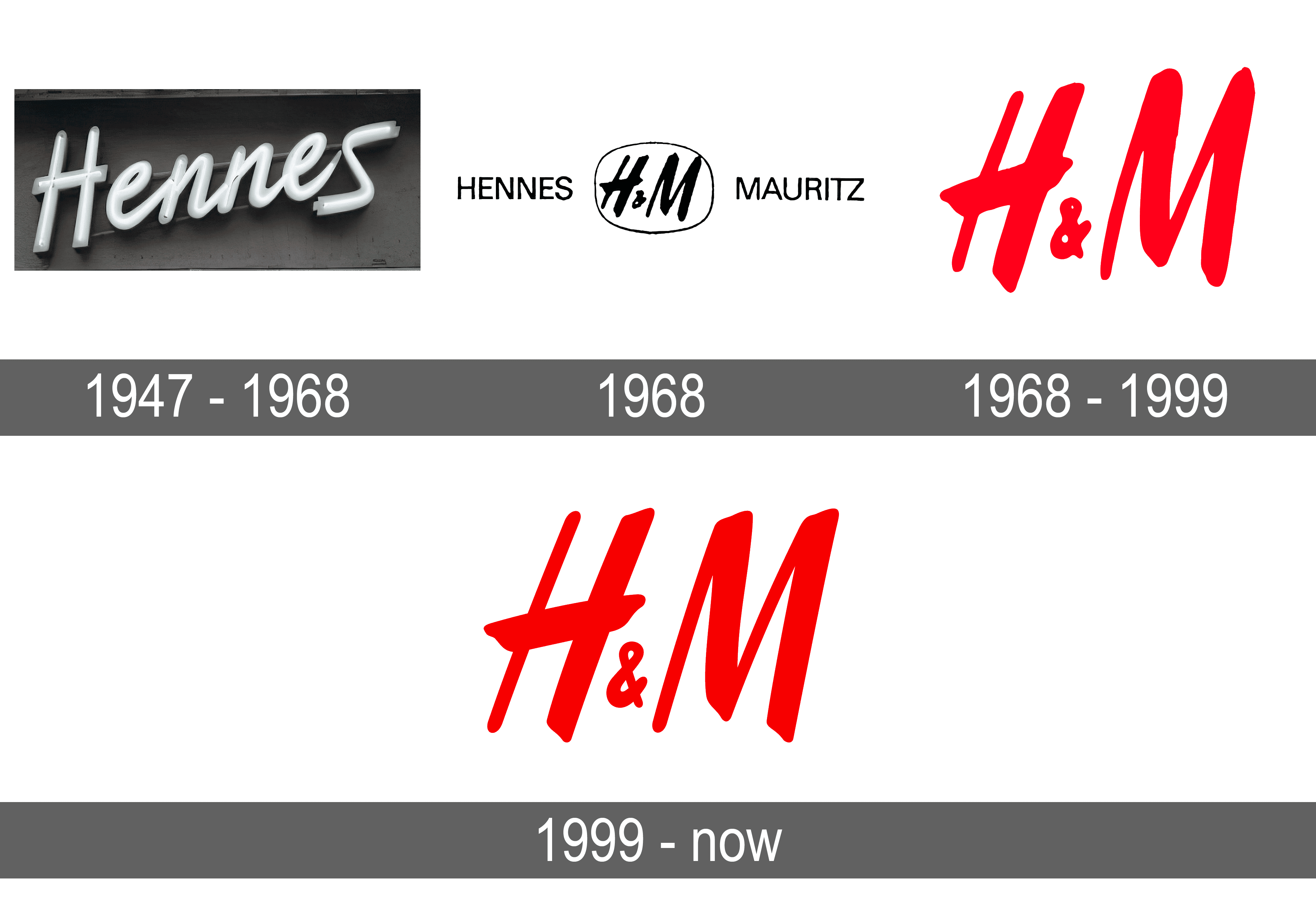
Why does H&M do marketing?
Similar to other companies, H&M also faces the common objectives of marketing and branding, such as introducing its brand and products to the market, boosting sales, and expanding its customer base. The clothing industry is fiercely competitive, fueled by increasing fashion awareness worldwide. As a brand deeply integrated into people’s lives, H&M is subject to societal expectations and pressures.
In response, H&M’s branding strategies have consistently emphasized its commitment to societal concerns and responsibilities. By aligning its marketing campaigns with moral values and ethics, H&M seeks to resonate with customers and cultivate a positive brand image.
Market Research
This including both primary and secondary research.
Buyer Persona
Before starting to learn about the market, marketers need to know who they’re trying to sell to. H&M is a fast-fashion brand that’s kind of like a mid-level luxury brand in places like India. Because of this, it’s more popular in big cities. H&M mostly tries to appeal to young people, usually between 16 and 25 years old.
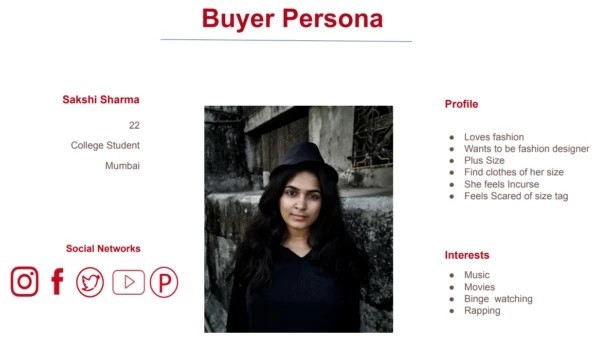
Market Analysis
H&M competes with big names like Zara and Forever21 in the fashion world. Zara is the top dog, followed closely by H&M, with Forever21 trailing behind. Each company has its own focus: Forever21 is all about party clothes and has fewer sizes, while H&M offers a wider range of sizes and everyday clothes. Zara is in the middle, offering more high-fashion stuff. Because online sales are super important, researchers looked into how each company does online. H&M gets a lot of people visiting its website naturally, but Zara does a great job reaching people online by using popular keywords like “jumpsuit” and “camisole.” Zara’s online business is growing faster than H&M’s.
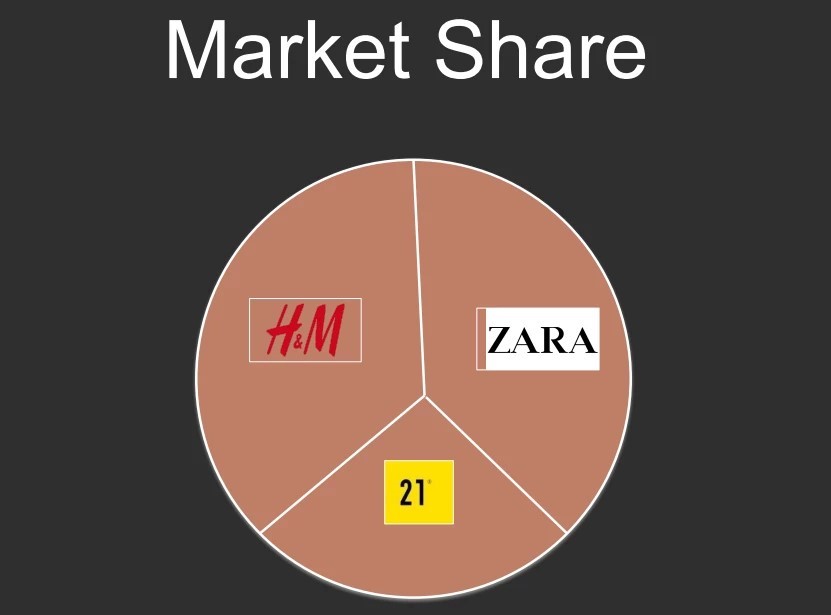
Market Gap Analysis
To identify potential areas for improving sales through marketing efforts, the primary research was conducted by taking public poles and they found the following market perceptions:
- 82% of respondents perceive that brands do not offer inclusive sizing options.
- 65% of respondents feel insecure due to the limited availability of sizes in brands.
- 55% of users are unaware that H&M offers clothing in all sizes.
Based on these findings, we concluded that there is a need to market H&M’s existing feature of offering clothing in all sizes. They developed a marketing strategy solution based on their insights.
Top Marketing Campaigns
Here is a list of the top offline marketing campaigns of H&M that have made the brand what it is today, one of the top clothing retailers in the world.
H&M Conscious
H&M came up with a smart idea to make people think about shopping in an eco-friendlier way. They launched the Conscious collection, where at least half of the materials used are sourced sustainably and organically. When people buy stuff from this collection, they get rewarded with “conscious points.” H&M also introduced the “Loop” machine, which turns old clothes into new ones in just five hours. This cool invention shows that H&M cares about making good quality stuff and using eco-friendly ways to make it.
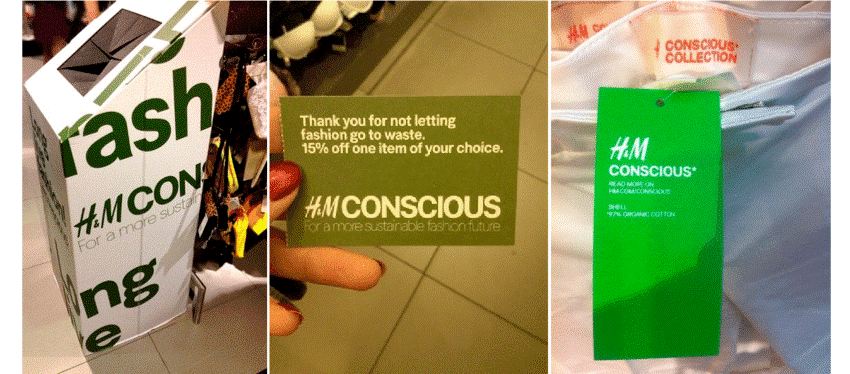
Bring IT
H&M started a campaign called “Bring It!” They made a short film to encourage people to bring their old clothes to H&M stores. The film shows how these clothes can still be useful. The campaign is open to all kinds of clothes from any brand. People who bring in a bag of clothes get vouchers or discounts for their next purchase. This idea worked well, with H&M collecting over 40,000 tons of clothes since the campaign started. They’re aiming to collect 25,000 tones every year by 2020.

H&M for All
The “H&M For All” campaign is designed to highlight a unique aspect of the brand that many people might not know about. It’s all about promoting body positivity and acceptance. The campaign uses lots of content created by influencers to spread the message. It’s going to last for a month, with the goal of getting more people to know about it.
With “H&M For All,” the brand wants to challenge the usual idea of beauty and encourage everyone to feel good about themselves. They’re going to share lots of interesting and helpful content to teach people about the importance of embracing different kinds of beauty in fashion.
The aim is to make people feel confident and happy in their own bodies. “H&M For All” isn’t just a campaign; it’s a movement towards making the fashion industry more inclusive and accepting. By celebrating diversity and showing all kinds of people in their clothes, H&M hopes to make a positive change and make fashion more welcoming for everyone.
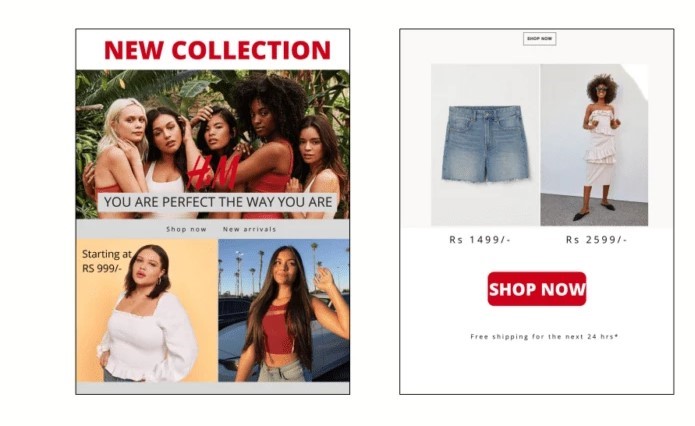
Brighter Than Ever
H&M launched a campaign called “Brighter than Ever” to celebrate the festive season. They introduced a new collection with colorful clothes and home decorations that sparkle and shine. The campaign focused on using bright colors and shiny designs like sequins and fringes. They also featured famous Indian celebrities like Manushi Chillar and Shantanu Maheshwari to appeal to young people.
One special thing about this campaign was that it highlighted products made entirely in India, especially in the home decor section. This was meant to connect with local customers. The campaign had a very festive Indian feel to it, which made people feel happy and excited.
The campaign also showed H&M’s commitment to the Indian market and culture by promoting locally made products. Overall, “Brighter Than Ever” was a successful way to spread joy and positivity during the festive season.
Overall, the “Brighter Than Ever” campaign successfully encapsulated the festive essence of India and spread cheer and excitement among customers during the festive season.

H&M SWOT Analysis
H&M Strengths
Here are some of the competitive advantages of the H&M brand.
Strong Brand Name
H&M is a really popular brand all over the world. People love it because they have stylish clothes that don’t cost a lot. They’re known for keeping up with the latest trends while still being affordable. Lots of people love shopping there because they know they’ll find cool clothes that won’t break the bank. Because of this, H&M has a lot of loyal customers and stays competitive in the fashion world.
Wide Product Range
H&M boasts an expansive product lineup that spans across multiple categories, including apparel, accessories, and home furnishings. This diverse range of offerings enables H&M to serve a broad spectrum of customers, catering to men, women, and children across various age demographics and style inclinations.
Through its extensive product range, H&M aims to provide customers with a one-stop shopping experience, where they can conveniently find everything, they desire under one roof. This approach underscores H&M’s commitment to being a dependable and accessible destination for all their fashion and lifestyle needs.
Fast Fashion Model
H&M has embraced the fast fashion model, known for its agility in responding promptly to the latest fashion trends and swiftly introducing new designs to the market. This strategy allows H&M to maintain a competitive edge by promptly adjusting to changing consumer tastes.
Through streamlined processes and effective supply chain management, H&M can introduce fresh collections and products at a rapid pace. This ensures that customers always have access to the latest trends while enjoying competitive pricing.
Global Presence
H&M has stores all over the world, which helps them reach lots of different people. This means they can sell their clothes in different countries and reach lots of customers. By opening stores in new places, H&M can keep up with the latest fashion trends and make sure they have something for everyone. It also helps them stay strong even if the market isn’t doing well in one place.
Supply Chain Management
H&M owes its success to its well-structured supply chain management system. The company has established streamlined procedures for manufacturing, distributing, and managing inventory, guaranteeing prompt product delivery to its retail outlets.
Through fostering solid partnerships with suppliers and meticulously overseeing production and logistics, H&M can streamline its processes and reduce expenses.
Thanks to its efficient supply chain, H&M can swiftly respond to customer needs, adjust to changes in the market, and maintain optimal inventory levels to prevent excess stock or stock outs.
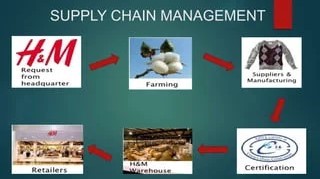
H&M Weaknesses
Here are some of the shortcomings of the H&M brand.
Sustainability Concerns
H&M has faced scrutiny over its environmental footprint and labor standards across its supply chain. Criticisms include concerns about high water consumption, chemical pollution, and waste generation in its production processes. Moreover, allegations of substandard working conditions and low pay in factories manufacturing H&M’s clothing have also surfaced. In response, H&M has pledged to address these sustainability issues by implementing recycling programs, incorporating sustainable materials, and advocating for fair labor practices.
Quality Perception
Although H&M prides itself on offering budget-friendly fashion, some shoppers view its products as less durable compared to pricier brands. This perception stems from H&M’s fast fashion approach, which prioritizes rapid production and lower costs.
Customers have raised concerns about issues like fabric longevity, stitching precision, and color retention. Nevertheless, H&M has taken steps to tackle these challenges by refining its product development process, enhancing quality checks, and partnering with reliable suppliers to uphold higher standards.
Through ongoing efforts to enhance product quality, H&M seeks to change this perception and offer customers improved value for their purchases.
Dependency on External Suppliers
H&M’s business heavily relies on external suppliers for its products, which brings about challenges related to maintaining quality and managing the supply chain effectively. The company operates through a vast network of suppliers globally, sourcing materials and manufacturing garments from various locations.
This reliance on external partners exposes H&M to various risks, including delays in production, capacity limitations, and potential inconsistencies in product quality across different suppliers. Additionally, unforeseen events such as natural disasters or political unrest can disrupt the supply chain, impacting the availability of products and ultimately affecting customer satisfaction.
To address these risks, H&M actively collaborates with its suppliers, enforcing stringent standards and conducting regular audits to ensure adherence to quality and compliance requirements. By maintaining close relationships with suppliers and implementing robust monitoring mechanisms, H&M strives to enhance supply chain resilience and mitigate potential disruptions.
H&M Opportunities
Here are some opportunities the business can capitalize on.
Expansion in Emerging Markets
H&M has an opportunity to strategically expand its presence in emerging markets, particularly in countries experiencing a growing middle class and increasing disposable income. These markets present a vast customer base that is becoming increasingly interested in fashion and seeking affordable yet trendy options.
By carefully analyzing market trends, consumer preferences, and cultural nuances, H&M can tailor its product offerings and marketing strategies to effectively cater to these emerging markets. Additionally, entering emerging markets allows H&M to reduce its reliance on mature markets and diversify its revenue streams, mitigating risks associated with economic downturns in specific regions.
E-commerce Growth
The burgeoning online retail landscape presents H&M with a promising opportunity to leverage the growing trend towards digital commerce. As consumers increasingly favor the convenience of online shopping, there is a substantial potential for H&M to expand its reach by bolstering its e-commerce capabilities.
By strengthening its online presence, optimizing its website and mobile application, and providing seamless shopping experiences, H&M can extend its customer outreach beyond brick-and-mortar stores. Strategic online marketing initiatives, tailored product recommendations, and intuitive interfaces can foster deeper customer engagement and drive sales growth.

Sustainability Initiatives
Investing in sustainable practices offers H&M an opportunity to resonate with eco-conscious consumers and set itself apart in the marketplace. With sustainability becoming increasingly paramount worldwide, shoppers are actively seeking out brands that prioritize ethical and environmentally sound practices.
By integrating sustainable sourcing methods, launching recycling programs, minimizing waste, and advocating for fair labor standards, H&M can establish itself as a socially responsible fashion retailer. Transparently communicating these sustainability efforts to customers and stakeholders will foster trust and loyalty, attracting a growing demographic of environmentally conscious consumer’s eager to support brands that align with their values.
Moreover, embracing sustainability measures can yield long-term cost benefits by enhancing resource efficiency and streamlining supply chain operations.
H&M Threats
Let’s take a look at some of the threats to the future survival of the company.
Intense Competition
In the fashion retail sector, competition is fierce, characterized by a multitude of players ranging from traditional physical stores to online platforms, all vying for market dominance. H&M not only contends with direct rivals within the fast fashion sector but also faces competition from upscale brands, department stores, and various other fashion retailers.
This competitive environment necessitates that H&M continuously innovates, distinguishes its product offerings, and presents a compelling value proposition to both attract and retain customers. Maintaining a robust brand presence, offering distinctive styles, delivering exceptional customer service, and remaining abreast of shifting fashion trends are pivotal strategies for H&M to maintain its competitive edge in this cutthroat market.
Key competitors include Zara, Forever 21, Uniqlo, Gap, and Primark, among others. Each competitor has its unique strengths and strategies, posing different threats to H&M’s market position. Zara, for example, is known for its agile supply chain and trend-focused designs, while Uniqlo emphasizes quality and innovation. Forever 21 targets younger demographics with affordable and trendy clothing, posing a direct threat to H&M’s customer base.
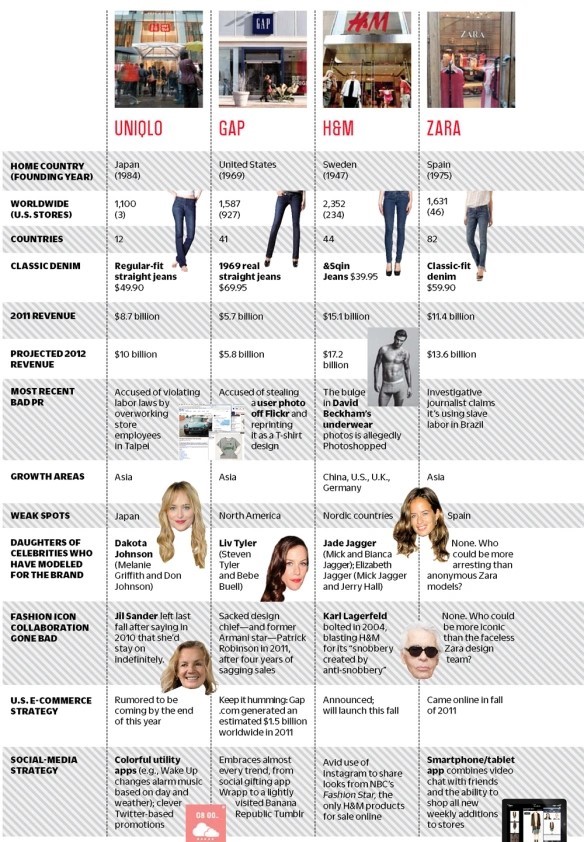
Changing Consumer Preferences
Consumer tastes and fashion trends are prone to swift changes, presenting H&M with the challenge of accurately predicting and meeting evolving customer preferences. The fashion industry’s dynamism means that what captures the market’s interest today may become obsolete tomorrow. To navigate this landscape, H&M must continually monitor market trends, collaborate with fashion influencers, and conduct thorough market research to gain insights into shifting consumer tastes.
Utilizing data analytics and customer feedback becomes imperative for H&M to remain agile and respond swiftly to evolving fashion preferences. The ability to adapt designs, integrate sustainable practices, and leverage social media platforms to gauge consumer sentiment is crucial for H&M to align its product offerings with changing consumer preferences effectively.
Economic Uncertainties
The fashion sector is vulnerable to economic shifts and downturns, which can profoundly influence consumer spending on non-essential items like apparel. During economic contractions or times of reduced consumer confidence, individuals may scale back their spending on fashion, resulting in decreased sales and profitability for H&M.
Economic instabilities, such as inflation, unemployment levels, or global economic circumstances, can impact consumers’ disposable income and their overall appetite for fashion goods. To address these challenges, H&M must diversify its product range, implement sound pricing tactics, and adjust its marketing strategies to accommodate shifting consumer behaviors across various economic climates.
Increasing Regulations
The fashion sector is encountering a surge in regulations pertaining to labor rights, environmental stewardship, and supply chain openness. Authorities, non-governmental organizations, and consumers are increasingly pressing for greater transparency and ethical conduct from fashion companies.
H&M must navigate these regulatory complexities by ensuring adherence to labor regulations, adopting sustainable sourcing and manufacturing methods, and fostering transparency throughout its supply chain. Compliance with these regulations may necessitate substantial investments in monitoring, auditing, and supplier collaboration.
Through proactive engagement with these regulatory challenges, H&M can mitigate reputational risks, bolster its brand reputation, and showcase its dedication to ethical and sustainable business operations.
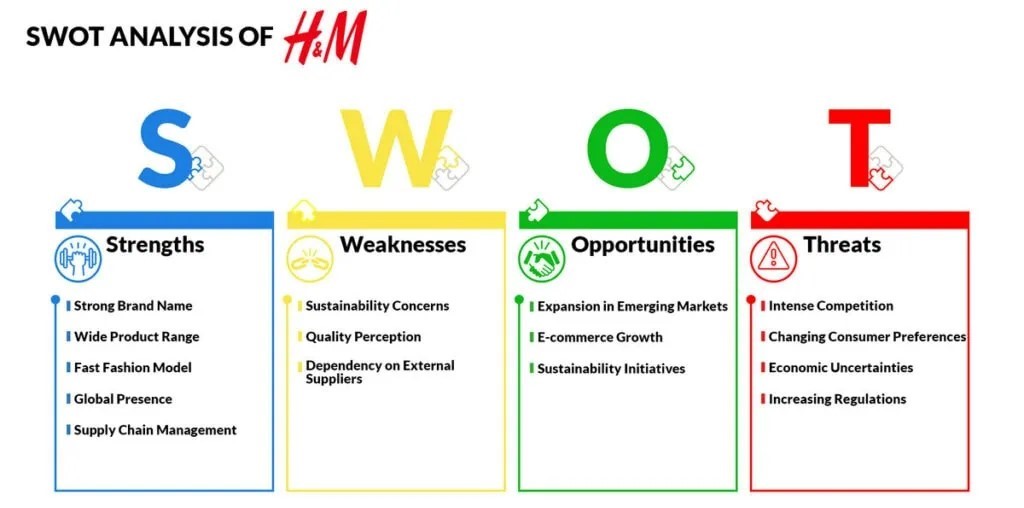
Secret to Its Success
H&M’s rapid expansion can be largely attributed to its adoption of the fast-fashion business model. Fast fashion revolves around swiftly moving goods from the design stage to store shelves, offering trendy and affordable items to young, style-conscious urban consumers. However, this approach has drawn criticism from advocates of ethical and sustainable consumer practices.
Central to the fast-fashion model is the constant turnover of products and rapid incorporation of the latest trends into the product lineup. H&M relies on a robust marketing team to quickly identify and respond to consumer preferences, ensuring a steady flow of in-demand items into the supply chain. Following Inditex, the parent company of Zara, H&M has emerged as the world’s second-largest fashion retailer. Both companies’ sustained success is driven by their adeptness in fast fashion, which involves identifying emerging trends and swiftly producing cost-effective versions of them.
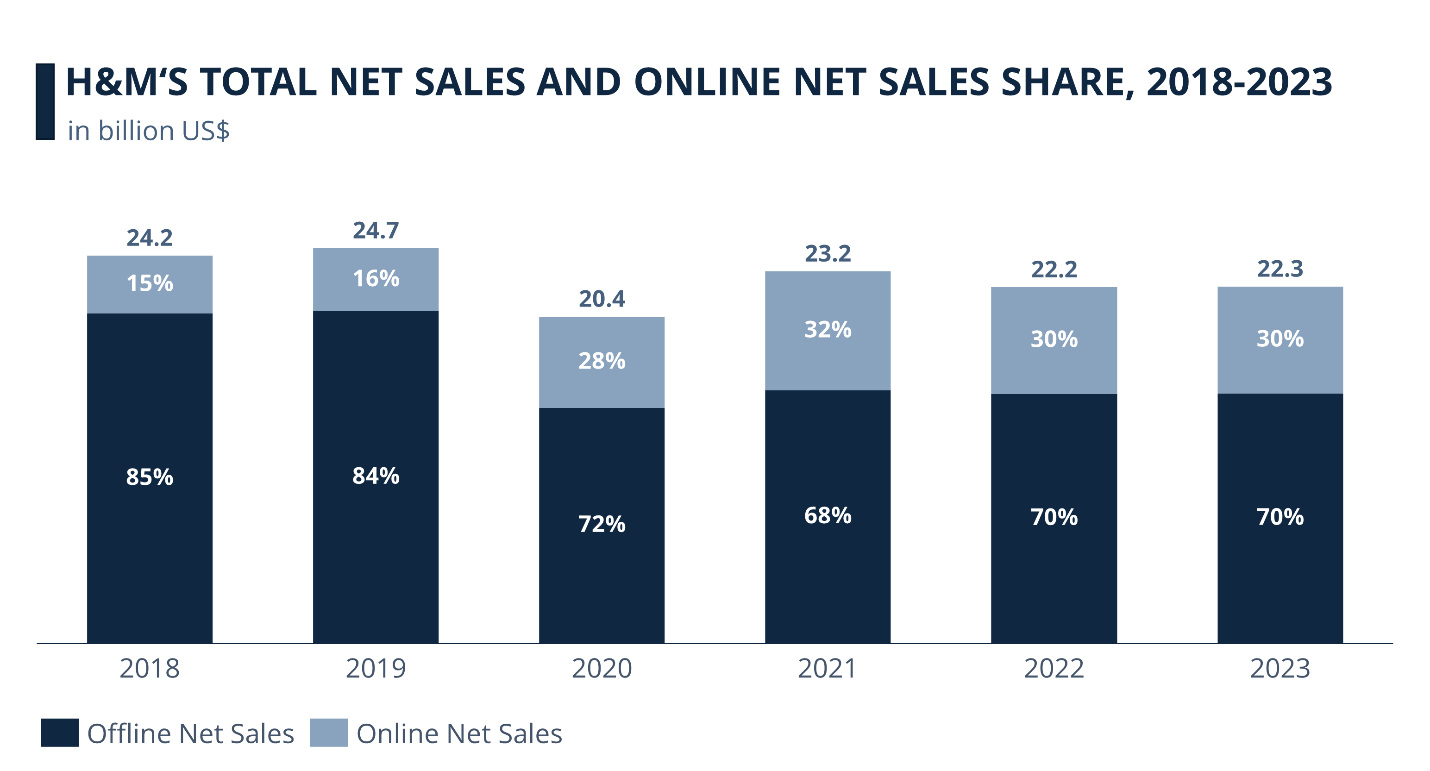
Conclusion
In Conclusion, H&M has solidified its position as a leading global fashion retailer, boasting a strong brand identity, diverse product offerings, efficient fast fashion model, extensive global reach, and effective supply chain management. These strengths have been instrumental in driving the company’s success and maintaining its competitive edge in the fashion retail sector.
However, H&M also grapples with several challenges and areas of improvement, including sustainability issues, perceptions of product quality, and reliance on external suppliers, fierce competition, shifting consumer preferences, economic instability, and tightening regulatory standards.
To ensure continued growth and success, H&M must seize opportunities such as expanding into emerging markets, capitalizing on the growth of e-commerce, and prioritizing sustainability initiatives. Additionally, addressing weaknesses by enhancing sustainability practices, improving product quality, and diversifying supplier partnerships will be crucial for the company’s long-term viability and relevance in the ever-evolving fashion industry.
Thank you for your interest and for reading!




